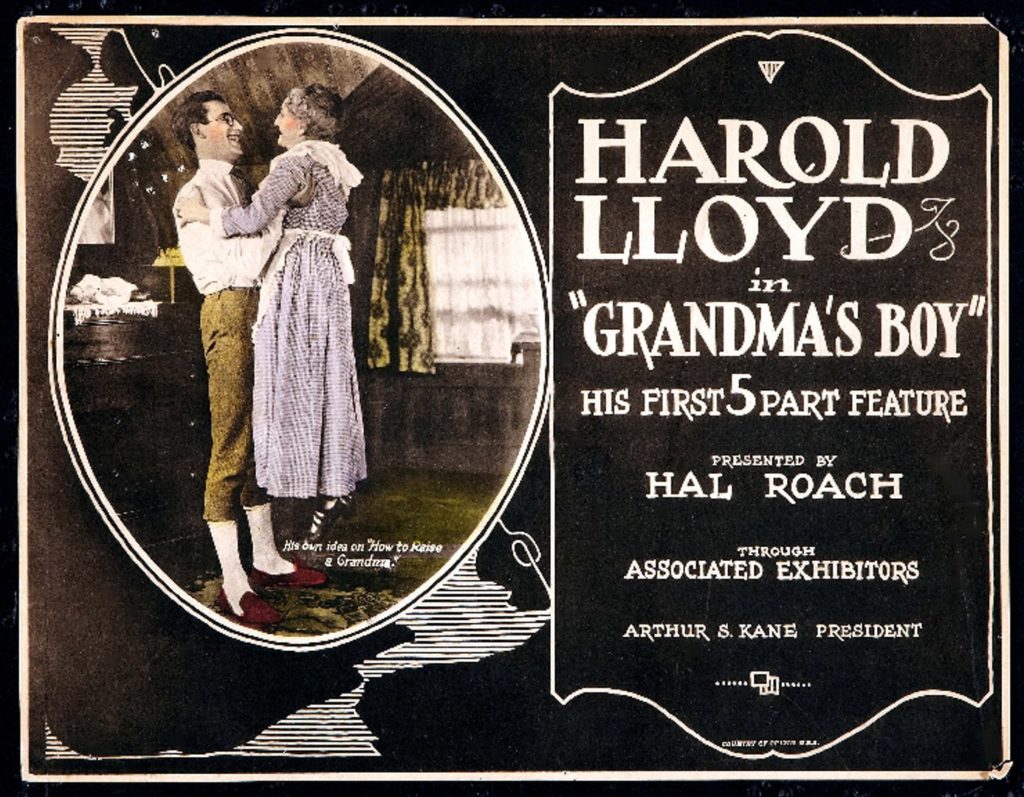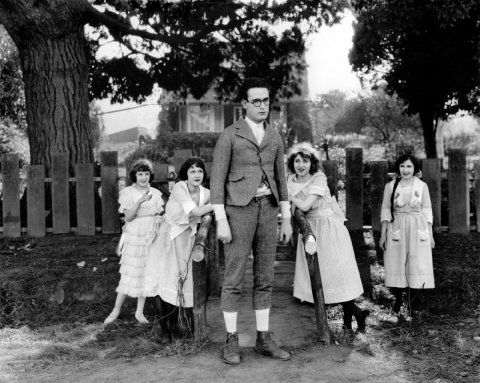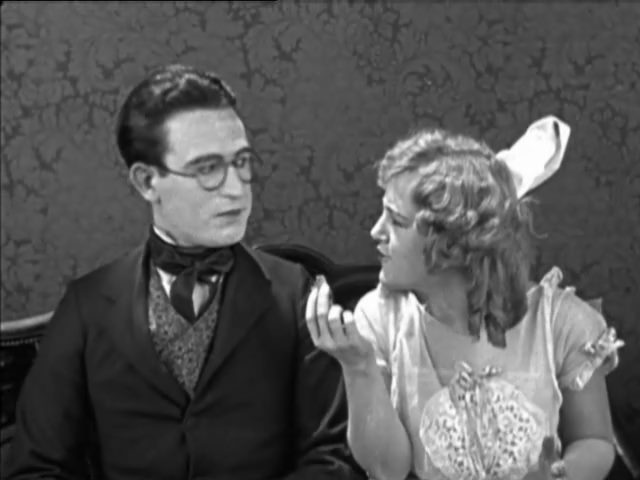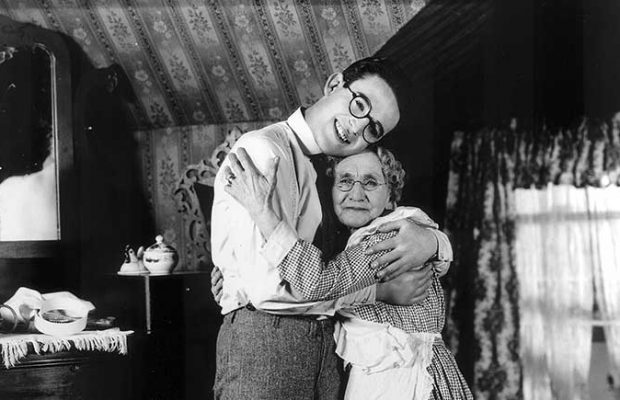Harold Lloyd Gains Impressive Confidence In First Full-Length Feature
1922/DIRECTED BY FRED C. NEWMEYER
PRESENTED: APRIL 13TH, 2019 at 2 and 7 PM/CAPITOL THEATER, OVERTURE CENTER
ORGANIST: ZACH FRAME

The 2019/20 Duck Soup season ended with whom it began, following one of Harold Lloyd’s final full-length silent features, 1927’s The Kid Brother, with his very first, 1922’s Grandma’s Boy. Adding drama and character development to the scores of two-, three-, and four-reel action- and stunt-oriented comedy shorts that preceded it, the longer, story-focused form allowed Lloyd’s often eponymous character, sometimes brash and bold but more often shy and fearful, to undergo a plot-infused transformation of personality. Perfectly reprised in the 125th anniversary year of the star’s birth, Grandma’s Boy comically dramatizes the passing of the Lloyd persona from boy to man, with help, of course, from the (positively) possessive title grandmother.
The pre-feature portion of the program began with three vaudeville acts, introduced by host Joe Thompson, that individually put the unseasonably cold April audience into the proper spirit of warmth and enjoyment. First up was Duck Soup mainstay Wayne the Wizard, whose veteran showmanship included a witty story-trick detailing his very first card-shuffling sleight-of-hand that inspired a lifetime of performing. An act called “Bobo and Zeee” followed with their five hundred-year history of African American performing and pop culture in their ten-minute lecture/duet combining the hand-and-body rhythmic stylings of “hambone” (Bobo; performance artist Nedra Bobo) with tap dance (Zeee; choreographer and performer Donna Peckett). Finally, yo-yo and spinning top-master Mark Hayward dazzled with his considerable skills and light, endearingly self-deprecating banter. A Wizard’s sword through host Thompson’s neck, a social contextualizing of blackface minstrelsy set to Bobo’s hambone and Zeee’s tap dance, and a top spinning approximately fifty feet over Hayward’s chin, respectively —bravura feats all — ended each performance of Duck Soup Cinema’s pre-feature vaudeville show.
Organist Zach Frame, brilliantly filling in for an indisposed Clark Wilson, introduced the film with a prefacing note on the Grand Barton’s current restoration: noting, if we had not yet noticed it ourselves, that the Grand Barton was in fact not there in its accustomed 91-year place stage right of Overture’s Capitol Theater stage. Two weeks before, Frame informed us, a fifty-three-foot-long semi-truck had pulled up alongside the State Street performance center and had loaded up the organ, its literally thousand pieces of pipes, fixtures, and miscellany — and even its metric tons of electrical blowers stored in the theater basement — off to a restoration facility in Nevada. Temporarily providing thundering theater organ effects before the Grand Barton’s eventual refurbishment some time next year, a digital console — with speakers placed in the now-empty pipe chambers — accompanied Duck Soup Cinema’s season-ending showing of Grandma’s Boy.

Set in a sleepy Midwestern town of dusty roads, hay barns, and cow pastures not unlike star Harold Lloyd’s rural Nebraskan upbringing — with a Main Street thoroughfare running down the center of it — the film opens with flashbacks to Harold’s infancy (wearing glasses even as a one-year-old) and picked-on childhood, showing his cowardly nature having a disastrous effect later in life on his under-confident adulthood. In love with the girl next door (Mildred Davis; Lloyd’s leading lady of the period, and later the star’s wife of 46 years), Lloyd’s too-passive character is unable to stand up to his bullying romantic rival (Charles Stevenson), who at one point strips Harold of his collar and tie and dumps the put-upon lad in a well, causing his no-shrink suit to comically shrink two (or three) sizes too small. Grandma (a delightful Anna Townsend) comes to the rescue with his grandfather’s mothball-preserved suit (a comic touch still apparent to even modern eyes in contrast to the surrounding, less florid cuts of 1920’s fashion), and further involves our bashful not-yet hero with tales of his progenitor’s similar struggle with bravery, the latter in a lengthy flashback (played by Lloyd in a Confederate uniform, mutton-chops, and of course wire-rims) given a mystical talisman by a mysterious gypsy-woman (?), and who so ends up capturing the entire command of the enemy forces.
In the present day, a murderous hobo (a menacing Dick Sutherland; billed as “The Rolling Stone”) is on the loose in the easily-threatened burg, and Lloyd sees this as an opportunity to prove his better nature when unaccountably appointed as a sheriff’s deputy. Armed with his grandfather’s ancient talisman, Harold sets out to show to his grandma, girl, rival, and audience that true bravery comes from within.

At six reels, clocking just over or under an hour — depending on the rate of varying projection — Grandma’s Boy, again, is the popular comedy star’s first foray into feature filmmaking. Premiering around the same time many of his contemporaries, including Charlie Chaplin and Buster Keaton, were also making their first comedies with three-act structures, the challenge of sustaining an audience’s attention beyond the one- or two-act “situation” of the short-length form was considerable for these comedy pioneers. Chaplin’s The Kid, from 1921, had rounded out its plot of a pint-size street urchin and his mini-mustachioed Tramp protector with the comedian’s considerable taste for pathos and melodrama, inspired by the comedy mega-star’s tragic and impoverished upbringing, while Keaton, two years later in 1923, with Three Ages, shown last year at Duck Soup Cinema, grafted three comic shorts parodying “love through the ages” in parallel caveman, Roman, and modern settings, respectively.
Lloyd’s own story-solution to the feature-length form in Grandma’s Boy, characteristically, is character-based, where the gags, set-pieces, and visual punchlines are determined on a seemingly moment-by-moment basis by an accumulation of comic details alongside the character’s developing plight. As mentioned, having his clothes destroyed in one early scene — with his character walking down the dusty road in tight-fitting, shrunken shirt-and-pants to the ridicule of his neighbors — only to later suffer through the rest of the film in a suit of clothes then-sixty years out-of-date is but one series of humiliations heaped upon his character that not only drives the plot forward but also strengthens poor Harold’s resolve. With always keen ingenuity, a candy box filled with mothballs, a glass of gasoline, a roadster driven over off-road terrain, various objects mistaken for a loaded gun, the figure on the end of an umbrella, and a comic-dramatic return to the very well-dump where all the comedy-drama began — to name but a few of the story-elements involved without giving too much away about their individually brilliant use — are all the funnier for being uniformly rooted in character and, more importantly, for enacting a symphony of deepening detail that propel the film forward and tell the story of the character’s social (and personal) development.
Most of all, though, it’s Harold himself who provides this level of identification with his character, and by extension his audience, and while it is a foregone conclusion from frame one that his “fraid cat” character (as etched on a school-slate, complete with glasses, on an early screen title) will find his confidence, the respect of his peers, and the love of his girl by frame zed — thanks to the endearing agency of his Irish Jig-dancing grandmother, of course — it is nonetheless satisfying, and indeed empowering, to witness this type of story so well-told. Thanks to Duck Soup Cinema, Overture Center’s Capitol Theater, and organist Zach Frame — along with the pre-show acts that fully contribute to this spell of yesteryear — Grandma’s Boy remains an unqualified success story, still resonant and involving in the 125th anniversary year of its star’s birth.


